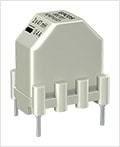source: TDK news
TDK Corporation presents a new series of EPCOS ring-core double chokes. The new B82721K2*U* series of RoHS-compatible power line chokes have been developed in particular for use in home appliances such as washing machines and dishwashers, refrigerators and heating control units.
The plastic used (flame-retardant, compliant with UL 94 V-0) with a CTI value of 600 is certified in accordance with IEC 60335-1, clause 30 (glow-wire and ball pressure test) and the complete encapsulation of the winding allows it to be used in environments with the highest degree of pollution.
These chokes are designed for a rated voltage of 250 V AC and the range of inductance values extends from 0.4 mH to 47 mH. Depending on the inductance, their rated currents range from 0.4 A to 2.8 A, while the rated ambient temperature is +70 °C. The dimensions for all versions are 13.2 mm x 18.2 mm x 20 mm.
The components have been certified by UL and VDE according to corresponding component standards (UL 1283, IEC 60938-2).
Main applications
- Power supplies, home appliances and heating control units
Main features and benefits
- Compatibility with applications in accordance with IEC 60335-2 with CTI >250 and degree of pollution 3
- High rated current and rated temperature
































